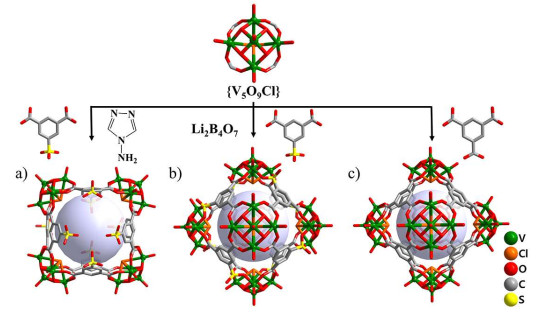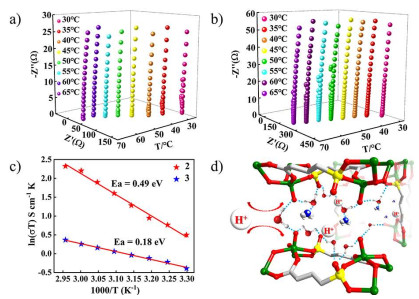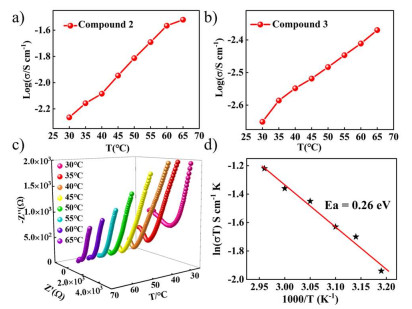-
[1]
Chu, S.; Majumdar, A. Opportunities and challenges for a sustainable energy future. Nature 2012, 488, 294-303.
doi: 10.1038/nature11475
-
[2]
Wang, S. Y.; Jiang, S. P. Prospects of fuel cell technologies. Natl. Sci. Rev. 2017, 4, 161-163.
doi: 10.1093/nsr/nwx032
-
[3]
Guo, Z. M.; Perez-Page, M.; Chen, J. N.; Ji, Z. Q.; Holmes, S. M. Recent advances in phosphoric acid-based membranes for high-temperature proton exchange membrane fuel cells. J. Energy Chem. 2021, 63, 393-429.
doi: 10.1016/j.jechem.2021.06.024
-
[4]
Zhang, H. W.; Shen, P. K. Recent development of polymer electrolyte membranes for fuel cells. Chem. Rev. 2012, 112, 2780-2832.
doi: 10.1021/cr200035s
-
[5]
Jiao, K.; Xuan, J.; Du, Q.; Bao, Z. M.; Xie, B.; Wang, B. W.; Zhao, Y.; Fan, L. H.; Wang, H. Z.; Hou, Z. J.; Huo, S.; Brandon, N. P.; Yin, Y.; Guiver, M. D. Designing the next generation of proton-exchange membrane fuel cells. Nature 2021, 595, 361-369.
doi: 10.1038/s41586-021-03482-7
-
[6]
Chen, J. N.; Bailey, J. J.; Britnell, L.; Perez-Page, M.; Sahoo, M.; Zhang, Z.; Strudwick, A.; Hack, J.; Guo, Z. M.; Ji, Z. Q.; Martin, P.; Brett, D. J. L.; Shearing, P. R.; Holmes, S. M. The performance and durability of hightemperature proton exchange membrane fuel cells enhanced by single-layer graphene. Nano Energy 2022, 93, 106829.
doi: 10.1016/j.nanoen.2021.106829
-
[7]
Lim, D. W.; Kitagawa, H. Proton transport in metal-organic frameworks. Chem. Rev. 2020, 120, 8416-8467.
doi: 10.1021/acs.chemrev.9b00842
-
[8]
Liu, R. l.; Wang, D. Y.; Shi, J. R.; Li, G. Proton conductive metal sulfonate frameworks. Coord. Chem. Rev. 2021, 431, 213747.
doi: 10.1016/j.ccr.2020.213747
-
[9]
Xie, X. X.; Yang, Y. C.; Dou, B. H.; Li, Z. F.; Li, G. Proton conductive carboxylate-based metal-organic frameworks. Coord. Chem. Rev. 2020, 403, 213100.
doi: 10.1016/j.ccr.2019.213100
-
[10]
Wahiduzzaman, M.; Wang, S. J.; Schnee, J.; Vimont, A.; Ortiz, V.; Yot, P. G.; Retoux, R.; Daturi, M.; Lee, J. S.; Chang, J. S.; Serre, C.; Maurin, G.; Devautour-Vinot, S. A high proton conductive hydrogen-sulfate decorated titanium carboxylate metal-organic framework. ACS Sustain. Chem. Eng. 2019, 7, 5776-5783.
doi: 10.1021/acssuschemeng.8b05306
-
[11]
Xue, W. L.; Deng, W. H.; Chen, H.; Liu, R. H.; Taylor, J. M.; Li, Y. K.; Wang, L.; Deng, Y. H.; Li, W. H.; Wen, Y. Y.; Wang, G. E.; Wan, C. Q.; Xu, G. MOF-directed synthesis of crystalline ionic liquids with enhanced proton conduction. Angew. Chem. Int. Ed. 2021, 60, 1290-1297.
doi: 10.1002/anie.202010783
-
[12]
Lin, Y.; Li, W. H.; Wen, Y. Y.; Wang, G. E.; Ye, X. L.; Xu, G. Layer-by-layer growth of preferred-oriented MOF thin film on nanowire array for high-performance chemiresistive sensing. Angew. Chem. Int. Ed. 2021, 60, 25758-25761.
doi: 10.1002/anie.202111519
-
[13]
Guo, S. S.; Huang, L. L.; Ye, Y. X.; Liu, L. Z.; Yao, Z. Z.; Xiang, S. C.; Zhang, J. D.; Zhang, Z. J. Carbazole based anionic MOF for proton conductivity. Chin. J. Struct. Chem. 2021, 40, 55-60.
-
[14]
Hana, W.; Kwana, S. M.; Yeung, K. L. Zeolite applications in fuel cells: water management and proton conductivity. Chem. Eng. J. 2012, 187, 367-371.
doi: 10.1016/j.cej.2012.01.102
-
[15]
Xu, H.; Tao, S. S.; Jiang, D. L. Proton conduction in crystalline and porous covalent organic frameworks. Nat. Mater. 2016, 15, 722-726.
doi: 10.1038/nmat4611
-
[16]
Jin, E. Q.; Geng, K. Y.; Fu, S.; Yang, S.; Kanlayakan, N.; Addicoat, M. A.; Kungwan, N.; Geurs, J.; Xu, H.; Bonn, M.; Wang, H. I.; Smet, J.; Ko-walczyk, T.; Jiang, D. l. Exceptional electron conduction in two-dimensional covalent organic frameworks. Chem 2021, 7, 3309-3324.
doi: 10.1016/j.chempr.2021.08.015
-
[17]
Liu, L.; Yin, L. Y.; Cheng, D. M.; Zhao, S.; Zang, H. Y.; Zhang, N.; Zhu, G. S. Surface-mediated construction of an ultrathin free-standing covalent organic framework membrane for efficient proton conduction. Angew. Chem. Int. Ed. 2021, 60, 14875-14880.
doi: 10.1002/anie.202104106
-
[18]
Liu, G. M.; Ma, W. J.; Wang, Y.; Yang, Y.; Song, X. J. Computational insights into the excited state intramolecular proton transfer reactions in ortho-hydroxylated oxazolines. Chin. J. Struct. Chem. 2021, 40, 540-548.
-
[19]
Gosselin, A. J.; Rowland, C. A.; Bloch, E. D. Permanently microporous metal-organic polyhedra. Chem. Rev. 2020, 120, 8987-9014.
doi: 10.1021/acs.chemrev.9b00803
-
[20]
Fujita, D.; Ueda, Y.; Sato, S.; Mizuno, N.; Kumasaka, T.; Fujita, M. Self-assembly of tetravalent Goldberg polyhedra from 144 small components. Nature 2016, 540, 563-566.
doi: 10.1038/nature20771
-
[21]
Yamashina, M.; Tanaka, Y.; Pittelkow, M.; Nitschke, J. R.; Lavendomme, R.; Ronson, T. K. An antiaromatic-walled nanospace. Nature 2019, 574, 511-515.
doi: 10.1038/s41586-019-1661-x
-
[22]
Jiao, J. J.; Tan, C. X.; Li, Z. J.; Liu, Y.; Han, X.; Cui, Y. Design and assembly of chiral coordination cages for asymmetric sequential reactions. J. Am. Chem. Soc. 2018, 140, 2251-2259.
doi: 10.1021/jacs.7b11679
-
[23]
Dong, J. Q.; Liu, Y.; Cui, Y. Supramolecular chirality in metal-organic complexes. Acc. Chem. Res. 2021, 54, 194-206.
doi: 10.1021/acs.accounts.0c00604
-
[24]
Wei, J. W.; Zhao, L.; He, C.; Zheng, S. J.; Reek, J. N. H.; Duan, C. Y. Metal-organic capsules with NADH mimics as switchable selectivity regulators for photocatalytic transfer hydrogenation. J. Am. Chem. Soc. 2019, 141, 12707-12716.
doi: 10.1021/jacs.9b05351
-
[25]
Li, Y. G.; Dong, J. Q.; Gong, W.; Tang, X. H.; Liu, Y. H.; Cui, Y.; Liu, Y. Artificial biomolecular channels: enantioselective transmembrane trans-port of amino acids mediated by homochiral zirconium metal-organic cages. J. Am. Chem. Soc. 2021, 143, 20939-20951.
doi: 10.1021/jacs.1c09992
-
[26]
Guo, T. T.; Cheng, D. M.; Yang, J.; Xu, X. X.; Ma, J. F. Calix[4]resorcinarene-based [Co16] coordination cages mediated by isomorphous auxiliary ligands for enhanced proton conduction. Chem. Commun. 2019, 55, 6277-6280.
doi: 10.1039/C9CC01828J
-
[27]
Samanta, D.; Mukherjee, P. S. Component selection in the selfassembly of palladium(II) nanocages and cage-to-cage transformations. Chem. Eur. J. 2014, 20, 12483-12492.
doi: 10.1002/chem.201402553
-
[28]
Saha, R.; Samanta, D.; Bhattacharyya, A. J.; Mukherjee, P. S. Stepwise construction of self-assembled heterometallic cages showing high proton conductivity. Chem. Eur. J. 2017, 23, 8980-8986.
doi: 10.1002/chem.201701596
-
[29]
Zhai, Q. G.; Mao, C. Y.; Zhao, X.; Lin, Q. P.; Bu, F.; Chen, X. T.; Bu, X. H.; Feng, P. Y. Cooperative crystallization of heterometallic indium-chromium metal-organic polyhedra and their fast proton conductivity. Angew. Chem. Int. Ed. 2015, 54, 7886-7890.
doi: 10.1002/anie.201503095
-
[30]
Xing, W. H.; Li, H. Y.; Dong, X. Y.; Zang, S. Q. Robust multifunctional Zr-based metal-organic polyhedra for high proton conductivity and selective CO2 capture. J. Mater. Chem. A 2018, 6, 7724-7730.
doi: 10.1039/C8TA00858B
-
[31]
Liu, S. S.; Liu, Q. Q.; Huang, S. Z.; Zhang, C.; Dong, X. Y.; Zang, S. Q. Sulfonic and phosphonic porous solids as proton conductors. Coord. Chem. Rev. 2022, 451, 214241.
doi: 10.1016/j.ccr.2021.214241
-
[32]
Sun, S. H.; Zhang, Q. C.; Ye, X. L.; Kashi, C. E.; Li, W. H.; Wang, G. E.; Xu, G. High-humidity sensor of a new trinuclear Ti3-oxo cluster. Chin. J. Struct. Chem. 2022, 41, 2203070-2203076.
-
[33]
Li, S. J.; Zhao, Y.; Knoll, S.; Liu, R.; Li, G.; Peng, Q. P.; Qiu, P. T.; He, D. F.; Streb, C.; Chen, X. N. High proton-conductivity in covalently linked polyoxometalate-organoboronic acid-polymers. Angew. Chem. Int. Ed. 2021, 60, 16953-16957.
doi: 10.1002/anie.202104886
-
[34]
Sun, X. W.; Liu, S. M.; Zhang, S.; Dang, T. Y.; Tian, H. R.; Lu, Y.; Liu, S. X. High proton conductivity achieved by the self-assembly of POM-based acid-base adduct in SBA-15 over a wide range from -40 to 85 ℃. ACS Appl. Energy Mater. 2020, 3, 1242-1248.
doi: 10.1021/acsaem.9b02381
-
[35]
Misra, A.; Kozma, K.; Streb, C.; Nyman, M. Beyond charge balance: counter-cations in polyoxometalate chemistry. Angew. Chem. Int. Ed. 2020, 59, 596-612.
doi: 10.1002/anie.201905600
-
[36]
Liu, Y. W.; Liu, S. M.; Lai, X. Y.; Miao, J.; He, D. F.; Li, N.; Luo, F.; Shi, Z.; Liu, S. X. Polyoxometalate-modified sponge-like graphene oxide monolith with high proton-conducting performance. Adv. Funct. Mater. 2015, 25, 4480-4485.
doi: 10.1002/adfm.201501912
-
[37]
Buru, C. T.; Farha, O. K. Strategies for incorporating catalytically active polyoxometalates in metal-organic frameworks for organic transformations. ACS Appl. Mater. Interfaces 2020, 12, 5345-5360.
doi: 10.1021/acsami.9b19785
-
[38]
Ma, H. P.; Liu, B. L.; Li, B.; Zhang, L. M.; Li, Y. G.; Tan, H. Q.; Zang, H. Y.; Zhu, G. S. Cationic covalent organic frameworks: a simple platform of anionic exchange for porosity tuning and proton conduction. J. Am. Chem. Soc. 2016, 138, 5897-5903.
doi: 10.1021/jacs.5b13490
-
[39]
Gan, H. M.; Xu, N.; Qin, C.; Sun, C. Y.; Wang, X. L.; Su, Z. M. Equi-size nesting of Platonic and Archimedean metal-organic polyhedra into a twin capsid. Nat. Commun. 2020, 11, 4103.
doi: 10.1038/s41467-020-17989-6
-
[40]
Li, X. X.; Zhao, D.; Zheng, S. T. Recent advances in POM-organic frameworks and POM-organic polyhedra. Coord. Chem. Rev. 2019, 397, 220-240.
doi: 10.1016/j.ccr.2019.07.005
-
[41]
Zhang, Y. T.; Gan, H. M.; Qin, C.; Wang, X. L.; Su, Z. M.; Zaworotko, M. J. Self-assembly of goldberg polyhedra from a concave [WV5O11(RCO2)5(SO4)]3- building block with 5-fold symmetry. J. Am. Chem. Soc. 2018, 140, 17365-17368.
doi: 10.1021/jacs.8b10866
-
[42]
Zheng, S. T.; Zhang, J.; Li, X. X.; Fang, W. H.; Yang, G. Y. Cubic polyoxometalate-organic molecular cage. J. Am. Chem. Soc. 2010, 132, 15102-15103.
doi: 10.1021/ja105986b
-
[43]
Chang, Q.; Meng, X. Y.; Ruan, W. J.; Feng, Y. Q.; Li, R.; Zhu, J. Y.; Ding, Y.; Lv, H. J.; Wang, W.; Chen, G. Y.; Fang, X. K. Metal-organic cages with {SiW9Ni4} polyoxotungstate nodes. Angew. Chem. Int. Ed. 2022, 134, e202117637.
-
[44]
Gong, Y. R.; Qin, C.; Zhang, Y. T.; Sun, C. Y.; Pan, Q. H.; Wang, X. L.; Su, Z. M. Face-directed assembly of molecular cubes: in situ substitution of a predetermined concave cluster. Angew. Chem. Int. Ed. 2020, 59, 22034-22038.
doi: 10.1002/anie.202010824
-
[45]
Gong, Y. R.; Zhang, Y. T.; Qin, C.; Sun, C. Y.; Wang, X. L.; Su, Z. M. Bottom-up construction and reversible structural transformation of supramolecular isomers based on large truncated tetrahedra. Angew. Chem. Int. Ed. 2019, 58, 780-784.
doi: 10.1002/anie.201811027
-
[46]
Zhang, Z. J.; Wojtas, L.; Zaworotko, M. J. Organic-inorganic hybrid polyhedra that can serve as supermolecular building blocks. Chem. Sci. 2014, 5, 927-931.
doi: 10.1039/C3SC53099J
-
[47]
Zhang, Y. T.; Wang, X. L.; Li, S. B.; Song, B. Q.; Shao, K. Z.; Su, Z. M. Ligand-directed assembly of polyoxovanadate-based metal-organic polyhedra. Inorg. Chem. 2016, 55, 8770-8775.
doi: 10.1021/acs.inorgchem.6b01338
-
[48]
Liu, X.; Zhou, J.; Amarante, T. R.; Paz, F. A. A.; Fu, L. S. Vanadoborates: cluster-based architectures, preparation and properties. Dalton Trans. 2021, 50, 1550-1568.
doi: 10.1039/D0DT03820B
-
[49]
Chen, H.; Yu, Z. B.; Bacsik, Z.; Zhao, H. S.; Yao, Q. X.; Sun, J. L. Construction of mesoporous frameworks with vanadoborate clusters. Angew. Chem. Int. Ed. 2014, 53, 3608-3611.
doi: 10.1002/anie.201311122
-
[50]
Wu, Y. L.; Li, X. X.; Qi, Y. J.; Yu, H.; Jin, L.; Zheng, S. T. {Nb288O768(OH)48(CO3)12}: a macromolecular polyoxometalate with close to 300 niobium atoms. Angew. Chem. Int. Ed. 2018, 57, 8572-8576.
doi: 10.1002/anie.201804088
-
[51]
Jin, L.; Zhu, Z. K.; Wu, Y. L.; Qi, Y. J.; Li, X. X.; Zheng, S. T. Record high-nuclearity polyoxoniobates: discrete nanoclusters {Nb114}, {Nb81}, and {Nb52}, and extended frameworks based on {Cu3Nb78} and {Cu4Nb78}. Angew. Chem. Int. Ed. 2017, 56, 16288-16292.
doi: 10.1002/anie.201709565
-
[52]
Gong, Y. R.; Su, Z. M.; Wang, X. L. A polyoxometalate-based metal-organic polyhedron constructed from a {V5O9Cl} building unit with rhombicuboctahedral geometry. Acta Crystallogr. C Struct. Chem. 2018, 74, 1243-1247.
doi: 10.1107/S2053229618010689
-
[53]
Spek, A. L. PLATON SQUEEZE: a tool for the calculation of the disordered solvent contribution to the calculated structure factors. Acta Crystallogr. C Struct. Chem. 2015, 71, 9-18.
doi: 10.1107/S2053229614024929
-
[54]
Liu, L.; Yin, L. Y.; Cheng, D. M.; Zhao, S.; Zang, H. Y.; Zhang, N.; Zhu, G. S. Surface-mediated construction of an ultrathin free-standing covalent organic framework membrane for efficient proton conduction. Angew. Chem. Int. Ed. 2021, 60, 14875-14880.
doi: 10.1002/anie.202104106
-
[55]
Lin, J. M.; Li, N.; Yang, S. P.; Jia, M. J.; Liu, J.; Li, X. M.; An, L.; Tian, Q. W.; Dong, L. Z.; Lan, Y. Q. Self-assembly of giant Mo240 hollow opening dodecahedra. J. Am. Chem. Soc. 2020, 142, 13982-13988.
doi: 10.1021/jacs.0c06582
-
[56]
Kang, D. W.; Kang, M. J.; Hong, C. S. Post-synthetic modification of porous materials: superprotonic conductivities and membrane applications in fuel cells. J. Mater. Chem. A 2020, 8, 7474-7494.
-
[57]
Lee, J.; Lim, D. W.; Dekura, S.; Kitagawa, H.; Choe, W. MOP x MOF: collaborative combination of metal-organic polyhedra and metal-organic framework for proton conductivity. ACS Appl. Mater. Interfaces 2019, 11, 12639-12646.
-
[58]
Chai, S. C.; Xu, F. R.; Zhang, R. C.; Wang, X. L.; Zhai, L.; Li, X.; Qian, H. J.; Wu, L. X.; Li, H. L. Hybrid liquid-crystalline electrolytes with high-temperature-stable channels for anhydrous proton conduction. J. Am. Chem. Soc. 2021, 143, 21433-21442.
-
[59]
Zhu, M. H.; Iwano, T.; Tan, M. J.; Akutsu, D.; Uchida, S.; Chen, G. Y.; Fang, X. K. Macrocyclic polyoxometalates: selective polyanion binding and ultrahigh proton conduction. Angew. Chem. Int. Ed. 2022, 61, e202200666.
-
[60]
Liu, W. J.; Dong, L. Z.; Li, R. H.; Chen, Y. J.; Sun, S. N.; Li, S. L.; Lan, Y. Q. Different protonic species affecting proton conductivity in hollow spherelike polyoxometalates. ACS Appl. Mater. Interfaces 2019, 11, 7030-7036.
-
[61]
Zang, H. Y.; Chen, J. J.; Long, D. L.; Cronin, L.; Miras, H. N. Assembly of thiometalate-based {Mo16} and {Mo36} composite clusters combining [Mo2O2S2]2+ cations and selenite anions. Adv. Mater. 2013, 25, 6245-6249.
-
[62]
Zhang, F. M.; Dong, L. Z.; Qin, J. S.; Guan, W.; Liu, J.; Li, S. L.; Lu, M.; Lan, Y. Q.; Su, Z. M.; Zhou, H. C. Effect of imidazole arrangements on proton-conductivity in metal-organic frameworks. J. Am. Chem. Soc. 2017, 139, 6183-6189.
-
[63]
Shigematsu, A.; Yamada, T.; Kitagawa, H. Wide control of proton conductivity in porous coordination polymers. J. Am. Chem. Soc. 2011, 133, 2034-2036.
-
[64]
Lai, X. Y.; Liu, Y. W.; Yang, G. C.; Liu, S. M.; Shi, Z.; Lu, Y.; Luo, F.; Liu, S. X. Controllable proton-conducting pathways via situating polyoxometalates in targeting pores of a metal-organic framework. J. Mater. Chem. A 2017, 5, 9611-9617.
-
[65]
Liu, J. C.; Han, Q.; Chen, L. J.; Zhao, J. W.; Streb, C.; Song, Y. F. Aggregation of giant cerium-bismuth tungstate clusters into a 3D porous framework with high proton conductivity. Angew. Chem. Int. Ed. 2018, 57, 8416-8420.

 Login In
Login In







 DownLoad:
DownLoad:


